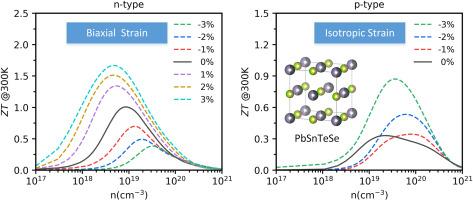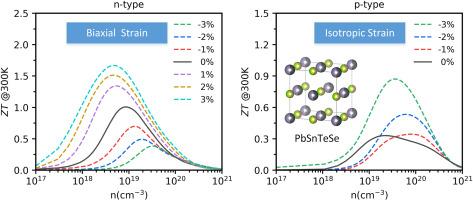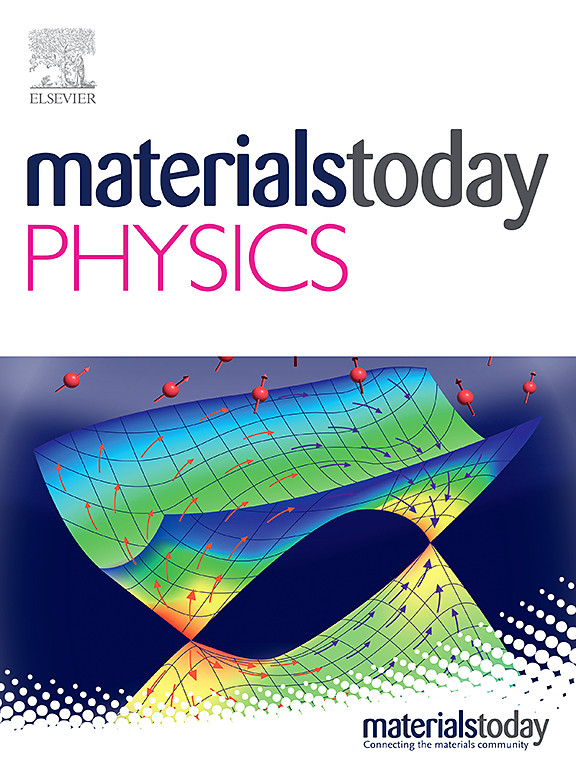Influence of biaxial and isotropic strain on the thermoelectric performance of PbSnTeSe high-entropy alloy: A density-functional theory study
IF 10
2区 材料科学
Q1 MATERIALS SCIENCE, MULTIDISCIPLINARY
引用次数: 0
Abstract
Strain engineering is an effective method to improve materials thermoelectric (TE) performance. In this study, both biaxial and isotropic strains ranging from −3% to +3 % and from −3% to −1%, respectively, were applied to improve the TE properties of PbSnTeSe high entropy alloy (HEA). The effects of strain on the TE transport properties of PbSnTeSe HEA were investigated using first-principles calculations combined with Boltzmann transport theory. Under biaxial strain, n-type doped PbSnTeSe HEA shows an increase in the optimal power factor () with both compressive and tensile strains. For p-type doping, compressive strain enhances the , whereas tensile strain reduces it. Within a strain range of −3% to +3 %, the optimal are 7.8–9.5 mW/mK2 for n-type and 0.85–1.3 mW/mK2 for p-type doped PbSnTeSe HEA. The maximum figure of merit () value of 1.63 for n-type doped PbSnTeSe HEA at 300 K under 3 % tensile strain is 61 % higher than the value of 1.1 without strain. Under isotropic strain ranging from 0 % to −3%, the increases from 7.8 to 14 mW/mK2 for n-type and from 1.1 to 3.4 mW/mK2 for p-type doped PbSnTeSe HEA. Additionally, isotropic strain boosts the maximum value for p-type doped PbSnTeSe HEA at 300 K from 0.3 to 0.85 under −3% strain. This study confirms that strain engineering is an effective strategy to enhance the thermoelectric properties of PbSnTeSe HEA.


双轴和各向同性应变对 PbSnTeSe 高熵合金热电性能的影响:密度泛函理论研究
应变工程是提高材料热电(TE)性能的有效方法。在本研究中,为了改善铅硒碲高熵合金(HEA)的 TE 性能,分别施加了 -3% 至 +3% 的双轴应变和 -3% 至 -1% 的各向同性应变。采用第一原理计算结合玻尔兹曼输运理论研究了应变对 PbSnTeSe 高熵合金 TE 输运特性的影响。在双轴应变下,n 型掺杂的 PbSnTeSe HEA 的最佳功率因数()随着压缩和拉伸应变的增加而增加。对于 p 型掺杂,压缩应变会提高最佳功率因数,而拉伸应变则会降低最佳功率因数。在 -3% 至 +3% 的应变范围内,n 型掺杂 PbSnTeSe HEA 的最佳功率因数为 7.8-9.5 mW/mK2,p 型掺杂 PbSnTeSe HEA 的最佳功率因数为 0.85-1.3 mW/mK2。在 300 K 条件下,n 型掺杂的 PbSnTeSe HEA 在 3% 拉伸应变下的最大功勋值()为 1.63,比无应变时的 1.1 高出 61%。在 0% 到 -3% 的各向同性应变下,n 型掺杂的 PbSnTeSe HEA 的应变值从 7.8 mW/mK2 增加到 14 mW/mK2,p 型掺杂的 PbSnTeSe HEA 的应变值从 1.1 mW/mK2 增加到 3.4 mW/mK2。此外,各向同性应变可将 300 K 时 p 型掺杂的 PbSnTeSe HEA 在-3%应变下的最大值从 0.3 提高到 0.85。这项研究证实,应变工程是提高 PbSnTeSe HEA 热电性能的有效策略。
本文章由计算机程序翻译,如有差异,请以英文原文为准。
求助全文
约1分钟内获得全文
求助全文
来源期刊

Materials Today Physics
Materials Science-General Materials Science
CiteScore
14.00
自引率
7.80%
发文量
284
审稿时长
15 days
期刊介绍:
Materials Today Physics is a multi-disciplinary journal focused on the physics of materials, encompassing both the physical properties and materials synthesis. Operating at the interface of physics and materials science, this journal covers one of the largest and most dynamic fields within physical science. The forefront research in materials physics is driving advancements in new materials, uncovering new physics, and fostering novel applications at an unprecedented pace.
 求助内容:
求助内容: 应助结果提醒方式:
应助结果提醒方式:


